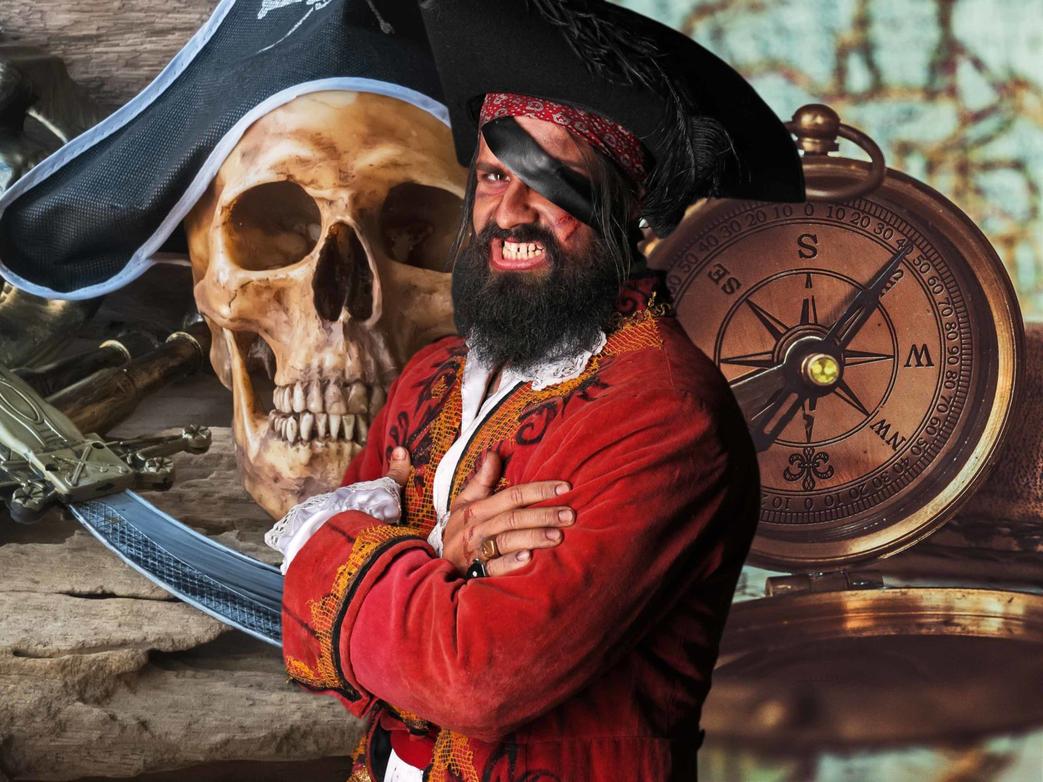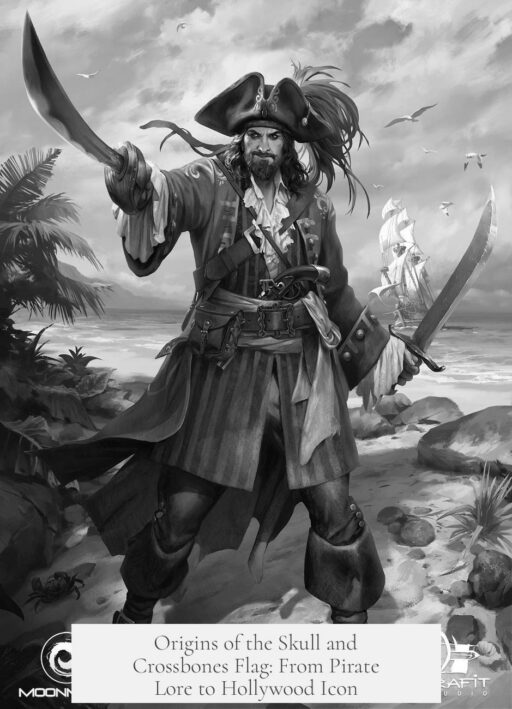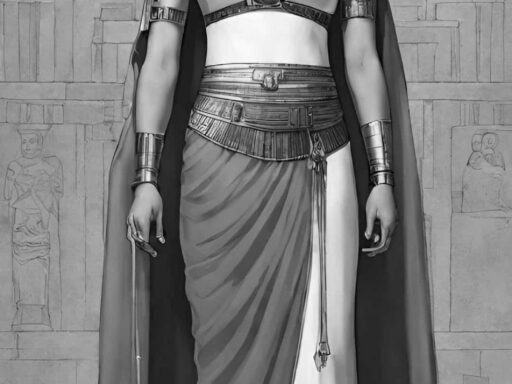The stereotypical skull and crossbones flag does have a genuine pirate origin, but Hollywood greatly shaped its modern, simplified image. Historically, the skull and crossbones design emerged among various pirate flags, particularly in the late 1600s and early 1700s. This symbol and its variations originated from actual pirates, possibly influenced by Barbary pirates or Muslim corsairs. Caribbean pirates adapted it with multiple designs across the Golden Age of Piracy.

Pirate flags were diverse in both color and iconography, and the skull and crossbones was only one among many. Some pirates preferred plain black flags, while French pirates often flew red flags signaling danger or bloodshed. Pirates such as Richard Worley, Emmanuel Wynne, “Calico Jack” Rackham, Edward England, and “Black Sam” Bellamy each used distinct versions of the skull and bones motifs.
Pirate captains used these flags strategically. They did not keep the pirate flag raised during their journey, as displaying one openly could lead to execution if captured. Instead, pirate ships sailed under “false colors,” flying the national flag friendly to their target ships to approach unsuspected. Only when close enough to attack did they reveal their true flag bearing threatening symbols like the skull and crossbones.

The reputation linked to the skull and crossbones flag was crucial. The sudden reveal intended to frighten the opposing crew into surrendering without a fight, conserving pirates’ resources and lives. Its clear imagery—death and warning—conveyed lethal consequences effectively. The name “Jolly Roger” referred broadly to pirate flags rather than this specific design, possibly stemming from the French phrase jolie rouge, meaning “pretty red,” associated with red pirate flags.
Hollywood adapted and standardized this historical complexity into a single, iconic image: the black flag with a white skull over crossed bones. The entertainment industry, films, and literature used this to symbolize piracy universally. Stories like Treasure Island, Peter Pan, and The Pirates of Penzance helped cement this symbol’s place in popular culture.
Hollywood’s portrayal simplifies pirate insignias, overlooking the variety and tactics of real pirates. The skull and crossbones is memorable and easy to reproduce, appealing to audiences with its unmistakable meaning. This widespread use overlooks the legal and practical reality that pirate flags were seldom exhibited openly and came in many variations. Instead, the symbol functions as a swift shorthand for piracy.
| Aspect | Historical Reality | Hollywood Portrayal |
|---|---|---|
| Flag Designs | Varied: black flags, red flags, various motifs, skull and crossbones among them | Single design: black flag with white skull and crossed bones |
| Use of Flag | Hidden until attack; false colors flown when approaching | Often shown flying openly |
| Symbol Meaning | Intimidation and threat of death used strategically | Universal pirate symbol |
| Term Jolly Roger | Applied to many pirate flags, possibly from French phrase | Often equated solely with skull and crossbones flag |
In essence, the skull and crossbones flag starts with pirate history but achieves modern fame through Hollywood’s influence. Its visual simplicity and immediate association with danger make it an effective emblem for storytelling. However, the full story involves a range of flags, tactics, and meanings among pirates themselves.
- The skull and crossbones pirate flag originates from real pirate use in the Caribbean and possibly from Barbary pirates.
- Pirates flew various flags, with skull and crossbones being just one of many designs.
- Pirates used flags strategically, hiding their true colors until the moment of attack.
- The term “Jolly Roger” referred broadly to pirate flags, not one specific design.
- Hollywood simplified and popularized the skull and crossbones flag as the universal symbol for pirates.
- The symbol’s prominence today owes much to its clarity and ease of recognition in media.
Where does the stereotypical skull and crossbones flag actually originate? Pirates or Hollywood?
The iconic skull and crossbones flag, famously known as the “Jolly Roger,” does originate from pirates, but the exact design and its universal fame owe a hefty debt to Hollywood’s creative lens.
Let’s unpack the murky waters of history and pop culture to find where this fearsome flag truly began. Was it the ruthless Caribbean pirates of yore? Or the imaginative studios spinning tales for the silver screen? Spoiler: It’s both, but with twists!
We’ll explore the real tale behind the flag, how pirates really used it, and how Hollywood turned it into the global icon it is today.
The Real Deal: Pirate Flags in History
Pirates in the Caribbean, the very hotbed of swashbuckling legends, did indeed fly flags. However, what they flew wasn’t a simple, universally recognized skull and crossbones design. Early on, flags varied widely. It was all about intimidation. A pirate flag signaled, “Surrender now or face death.” The stakes were real.
But here is a surprise: pirate ships did not parade around flying these flags all the time. Pirate fleets kept their true colors hidden, usually flying friendly or national flags to slip close to their prey unnoticed. Only when ready to strike would they unveil their dreaded emblem. This tactic, called “flying false colors,” was clever but treacherous.
Moreover, pirates faced serious consequences just for owning these flags. If caught, showing a pirate flag could, and often did, lead to hanging. The terror of these symbols was real and backed by harsh punishment.
Diversity in Pirate Flags: Not Just Skull and Crossbones
Here’s a fact many don’t know: before the skull and crossbones became the pirate flag poster child, the pirate flag scene was quite colorful.
- Flags were black, red, or even green—red especially symbolized danger and bloodshed.
- Some pirates, like Blackbeard, started flying plain black flags before switching to more fearsome images such as skeletons, bleeding hearts, or crossed swords.
- Each pirate captain often had a unique design to represent their own personal brand of terror on the seas.
Legendary pirates like Richard Worley, Emmanuel Wynne, and ‘Calico Jack’ Rackham flew different variations of death-themed flags. Among all these, the design favored by ‘Black Sam’ Bellamy—featuring the skull and crossed bones—rose to fame in the early 1700s. This is the version Hollywood immortalized.
Where Did the Skull and Crossbones Really Come From?
Interestingly, the design many associate with pirates—the skull and crossbones—may have actually originated from Barbary pirates or Muslim corsairs operating across the Mediterranean. The symbolism of death by bones and skull is an ancient and universal one.
In the Caribbean’s Golden Age of Piracy, versions of this flag took shape and were wielded by notorious figures, but the design was far from standardized. This patchwork of terror symbols eventually converged towards the popular “Jolly Roger” design around 1730.
The Meaning Behind the “Jolly Roger” Name
Another fun twist: The term “Jolly Roger” isn’t exclusively about the skull and crossbones. It applied broadly to pirate flags, no matter their design. Scholars speculate it might stem from the French phrase “jolie rouge,” meaning “pretty red,” referencing the alarming red pirate flag signifying no mercy.
So, the Jolly Roger was less a single flag and more a category of pirate horrors meant to send one message: don’t make us fight you, because we are deadly.
Hollywood’s Role: Simplification That Became Iconic
Fast forward to the 20th century, and here’s where Hollywood waves its magic wand.
Despite the historical diversity of pirate flags, Hollywood streamlined all pirate imagery into the skull and crossbones motif. The reasons? This design is simple, instantly recognizable, and packs a punch symbolically.
From movies to animated tales like “Treasure Island,” “Peter Pan,” and the operetta “The Pirates of Penzance,” the skull and crossbones became shorthand for “pirate” in the popular imagination. These stories popularized a flag image more evocative than historically precise.
It’s a classic case of “less is more.” While pirates flew many terrifying images—hourglasses reminding you time’s up, bleeding hearts, and speared harpoons—the skull and bones design cut to the chase. Even a child understands: death is coming.
Practical Pirate Flag Usage: It Was About Psychology
Behind the dramatic visual lay a cold strategic mind. Pirate flags were psychological weapons.
They had one main audience: the targeted ship’s crew. The flash of a deadly flag meant “surrender now or die.” This tactic often avoided actual fighting, as battles were costly and risky.
Hence, pirates usually cloaked their identity with false flags, only raising the Jolly Roger or its terrifying cousins at the crucial moment. This surprise reveal was designed to crush morale and force quick surrenders.
Why Does This Matter Today?
Understanding the real history of pirate flags moves us beyond clichés and Hollywood glam. It reveals pirates as crafty strategists, not just cartoon villains.
It also honors the culture and realism behind their symbols. The skull and crossbones did not start as a generic “pirate logo” but evolved through specific historical contexts, personal insignias, and strategic omissions.
When you see that white skull on black, remember, it wasn’t always this simple. And it wasn’t always about Hollywood drama.
Practical Tips If You Want to Dive Deeper
Curious about pirates beyond the Hollywood veneer? Pick up several of these well-researched books:
- Under the Black Flag by Richard Cordingly — a detailed look at pirate history.
- A General History of the Murders and Robberies of the Most Notorious Pirates (1724) — the classic pirate accounts that shaped much mythos.
- A History of Piracy by Angus Konstam — comprehensive and readable.
- Republic of Pirates by Colin Woodard — fascinating exploration of the pirate republics.
- The Invisible Hook by Peter Leeson — an economic look at piracy’s surprisingly rational methods.
- Barbary Legend by Godfrey Fisher — for insight into Mediterranean pirate origins.
These works provide perspective on the nuance and reality of pirate symbols and lives beyond the skull and crossbones meme.
Final Thoughts: Pirates, Flags, and the Power of Symbols
The stereotypical skull and crossbones flag is historically rooted in pirate usage, but it was never the whole story. Pirates flew many flags, used cunning tactics, and wielded vivid imagery to strike fear.
Hollywood distilled this rich tapestry into a simple, visual icon that fits neatly on a screen or T-shirt. That symbol now stands for piracy worldwide, but with some historical license.
So, where does the skull and crossbones originate? Both from the gritty, bloodied decks of the Caribbean and Mediterranean seas, and from Hollywood’s flair for drama and easy storytelling.
Next time you spot the Jolly Roger fluttering, consider the deep currents of history beneath it — a layered tale of fear, strategy, culture, and storytelling all entwined.




